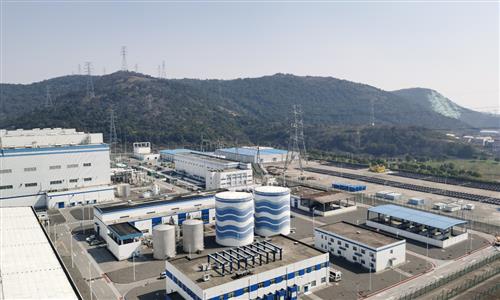David Die Dejean is passionate about studying tuna. Last year, he landed a dream job at National Oceanic and Atmospheric Administration in Miami to pursue his research.
By January, he was settled in, had received a good review and loved working with his colleagues, he said.
Then in mid-february he received an email to vacate the premises within 90 minutes. He and hundreds others had been dismissed in job cuts targeting probationary workers as US President Donald Trump’s new administration began slashing funding for universities and research bodies.
Now Die Dejean is applying for positions in Europe.
“I want to work wherever they allow me to do the research,” said the scientist, who studies fish stocks to ensure tuna is being fished sustainably.
“I’m eagerly waiting for some of the things that are coming from the European Union... increasing the opportunities for scientists like me to come back,” said Die Dejean, who was born in Spain but has spent most of his career in the United States and Australia.
Trump’s administration says billions of dollars in cuts are needed to curb the federal deficit and bring the US debt under control.
His cutbacks on research come amid a broader clash that has seen Trump criticise universities as discriminatory for their diversity policies and denounce what he sees as a failure by some institutions to protect Jewish students from antisemitism.
The threat to academics’ livelihoods at universities including Yale, Columbia and Johns Hopkins has given Europe’s political leaders hope they could reap an intellectual windfall.
A letter, reviewed by Reuters, signed in March by 13 European countries including France, Germany and Spain, urged the EU Commission to move fast to attract academic talent.
The European Research Council, an EU body that finances scientific work, told Reuters it would double the relocation budget for funding researchers moving to the EU to €2mil (Rm10mil) per applicant. That goes towards covering the cost of moving to a European institution, which may involve setting up a laboratory.
In Germany, as part of coalition talks for a new government, conservatives and Social Democrats have drawn up plans to lure up to 1,000 researchers, according to negotiation documents from March seen by Reuters that allude to the upheaval in US higher learning.
Reuters spoke to 13 European universities and research institutes that reported seeing an increase in Us-based employees considering crossing the Atlantic, as well as half a dozen Us-based academics pondering a move to Europe.
“Regulatory uncertainty, funding cuts, immigration restrictions, and diminished international collaboration create a perfect storm for brain drain,” said Gray Mcdowell of US digital consultancy firm Capgemini Invent.
A White House official said the administration is analysing research grants and prioritising funding for areas likely to deliver returns for taxpayers “or some sort of meaningful scientific advancement”. The NOAA cuts were designed to avoid compromising its ability to do its duties, the official added.
Pulling in US talent to Europe requires more than good will though. It requires money.
For decades, Europe has lagged far behind the United States on investment in its seats of higher learning. Total expenditure on research and development in the EU among businesses, governments, universities and private non-profit organisations in 2023 was €381bil, according to the latest figures by Eurostat – the statistical office of the European Union.
That same year, total research and experimental development in the United States was estimated at Us$940bil, according to the National Center for Science and Engineering Statistics, a federal agency that provides data on the performance of science and engineering in the United States.
And while the US’S richest university, Harvard, has an endowment worth Us$53.2bil that of Britain’s wealthiest, Oxford, is only £8.3bil.
One academic and an expert in academia said, even with a concerted and substantial effort, Europe would likely need a long time to overturn that spending advantage.
The White House official said even with the cuts, the United States would still account for the most global research funding, adding: “Europe is not going to and cannot fill the void.”
Dozens of scientists have taken to social media encouraging peers to stay in the United States, while others acknowledge a number of drawbacks may deter them from moving.
Michael Olesen, director of an infection prevention programme for a healthcare system in Washington, said language barriers were one potential drawback, as were unfamiliar laws and employment practices.
Salary is another. “My impression is that I would get paid a lot less as an anaesthesiologist in Europe,” said Holden K. Groves, an Assistant Professor of Anaesthesiology at Columbia University, which received funding from the National Institutes of Health (NIH). “It’s a huge ordeal to change.”
Still, Europe’s political leaders feel the stance of the Trump administration has put the wind in their sails.
“The American government is currently using brute force against the universities in the United States, so that researchers from America are now contacting Europe,” Germany’s chancellor-in-waiting, Friedrich Merz, said this month.
“This is a huge opportunity for us.” John Tuthill, a American neuroscience professor at the University of Washington in Seattle, is assessing his options.
He cannot apply for new funding to plan beyond 2027 because grant applications have now been frozen.
The lab of 17 people he runs gets about three-quarters of its funding from the NIH, where the Trump administration has earmarked major cuts.
“Europe is the obvious one, because it is the other hub of biomedical research in the world,” said Tuthill, adding he is weighing up a move with his wife and daughter.
Aix Marseille University in France said it had received interest from 120 researchers at institutions in the United States, including NASA and Stanford, for a €15mil “safe space for science” programme launched on March 7. The initiative aims to attract US staff from fields including health, LGBT+ medicine, epidemiology and climate change.
“Our colleagues were frightened... It was our duty to rise to the occasion,” university director Eric Berton said, noting 10 European universities have contacted him about launching similar programmes.
In the Netherlands, the government wants to establish a fund to attract top foreign scientists and bolster the EU’S ‘strategic autonomy’ aims, Education Minister Eppo Bruins said in a letter.
That marks a policy shift as the government had previously announced plans to cut half a billion euros in research and higher education.
Eindhoven Tech University President Robert-jan Smits told Reuters that bringing in US scientists could boost Europe’s technological sovereignty in areas like semiconductors.
Belgium’s sister universities Vrije Universiteit Brussel and Universite Libre de Bruxelles have launched a scheme encouraging Us-based researchers to apply for 36 postdoctoral positions. And the Alexander von Humboldt Foundation, which promotes the exchange of top scientists to Germany, plans to increase its programmes by about 20%.
The Grantham Institute at Imperial College London, which specialises in climate change research, is creating at least two more research fellowship posts for early-career climate researchers from the United States and has already seen an clear uptick in applications, said its Director of Research, Joeri Rogelj..- Reuters
America First,' science on the sidelines?: US-China ...












